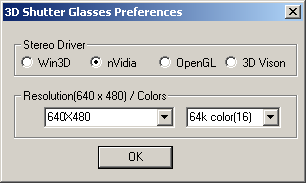
Full-screen page-flipping is supported by Winx3D, quad-buffered OpenGL, NVidia 3D Vision and nVidia stereo-drivers.
The default is "nVidia".

When using the Win3D or nVidia stereo drivers, the display-mode is full-screen with it's associated resolution and color-depth.
Page-flipping at that resolution and color-depth may not be supported by the graphics card or CRT monitor.
OpenGL uses the Desktop resolution and color-depth so selection of 'Resolution/Colors' in the dialog-box is not required. Note :
Quad-buffered stereo OpenGL is normally only supported by 'professional' video cards (such as the expensive nVidia 'Quadro' series used for CAD and similar, demanding applications).
In OpenGL mode, it is possible to increase and decrease the image-size with the mouse wheel.
Pressing
Stereo viewing with liquid-crystal shutter-glasses can be done two ways :-
- Interlaced Mode
- Page-flipped Mode (no interlacing)
Interlaced Mode
The even-numbered rows of one image are mixed with the odd-numbered rows of the other image (losing half of the vertical resolution in each image).
When SMP is displaying the even lines, the LCD glasses only allow one eye to see the image.
When the odd lines are displayed, only the other eye sees the image.
Two different viewpoints are presented to the brain which then perceives the scene 'with depth'.
Of course, you require a graphics-card or external controller thats supports interlacing and can synchronise the glasses to the display.
.
Page-flip (noninterlaced)
On the screen, each full-resolution left/right image is alternatively displayed at high speed and synchronised to the shutter-glasses so that the left eye sees the left image and the right eye sees the right image.
If the screen vertical refresh-rate is 100Hz or more, very little flicker (if any) will be observed.
This depends on your surroundings, subdued lighting is best and higher refresh-rates may actually produce increased 'ghosting'.
This mode requires a high-performance CRT monitor if high-resolutions are required.
Regrettably, the increasingly popular LCD displays cannot be used.
The stereo-driver ensures that the display is updated during the vertical-refresh period and that the shutter-glasses are synchronised to the left/right images.
However, there are hardware and software methods that can be used to convert an inexpensive, consumer-card into a 'Quadro'.
Try an Internet search using keyword 'SoftQuadro' for latest information.
Be aware that it will not work with all versions of the Detonator drivers.